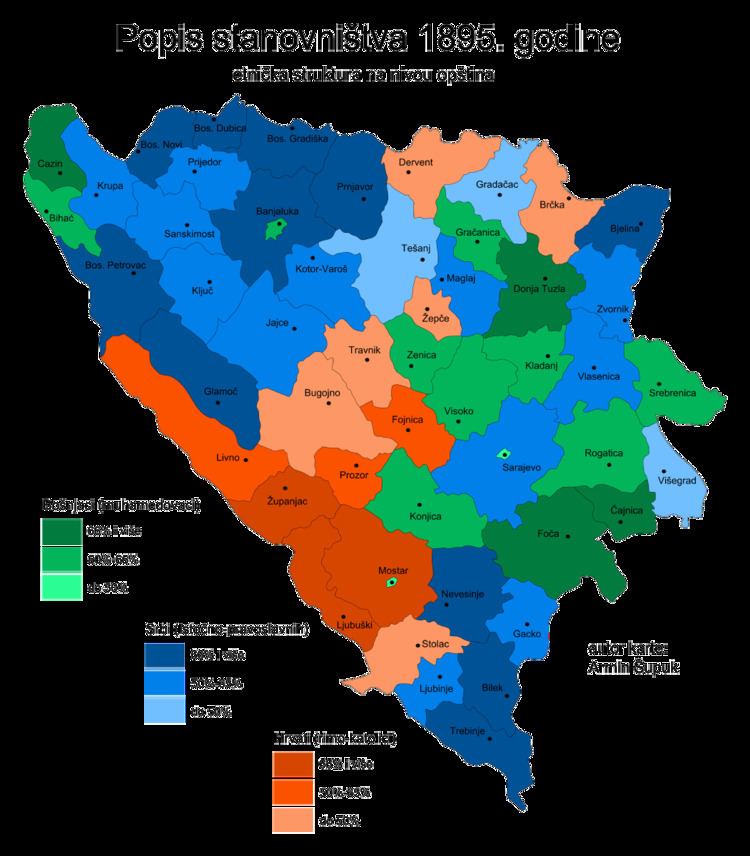 | ||
This article is about the demographic features of the population of Bosnia and Herzegovina, including population density, ethnicity, education level, health of the populace, economic status, religious affiliations and other aspects of the population.
Contents
- Map of Bosnia and Herzegovina
- Vital statistics
- Ethnic groups
- Languages
- Religion
- CIA World Factbook demographic statistics
- Population
- Age structure
- Median age
- Sex ratio
- Infant mortality rate
- Life expectancy at birth
- HIVAIDS
- Literacy
- References
Map of Bosnia and Herzegovina
Vital statistics
Ethnic groups
According to data from 2013 census published by the Agency for Statistics of Bosnia and Herzegovina, Bosniaks constitute 50.11% of the population, Bosnian Serbs 30.78%, Bosnian Croats 15.43%, and others form 2.73%, with the remaining respondents not declaring their ethnicity or not answering. The census results are contested by the Republika Srpska statistical office and by Bosnian Serb politicians, who oppose the inclusion of non-permanent Bosnian residents in the figures. The European Union's statistics office, Eurostat, however concluded the methodology used by the Bosnian statistical agency to be in line with international recommendations.
In Bosnia and Herzegovina, religion is often linked to ethnicity, i.e. (with the exception of agnostics and atheists) most Bosniaks are Muslim, Serbs are Orthodox Christian, and Croats are Roman Catholic.
Languages
Bosnia's constitution does not specify any official languages. However, academics Hilary Footitt and Michael Kelly note that the Dayton Agreement states that it is "done in Bosnian, Croatian, English and Serbian", and they describe this as the "de facto recognition of three official languages" at the state level. The equal status of Bosnian, Serbian and Croatian was verified by the Constitutional Court in 2000. It ruled that the provisions of the Federation and Republika Srpska constitutions on language were incompatible with the state constitution, since they only recognised "Bosniak" and Croatian (in the case of the Federation) and Serbian (in the case of Republika Srpska) as official languages at the entity level. As a result, the wording of the entity constitutions was changed and all three languages were made official in both entities. The three languages are mutually intelligible and are also known collectively as Serbo-Croatian. Use of one of the three varieties has become a marker of ethnic identity. Michael Kelly and Catherine Baker argue: "The three official languages of today's Bosnian state...represent the symbolic assertion of national identity over the pragmatism of mutual intelligibility". All standard varieties are based on the Ijekavian varieties of the Shtokavian dialect (non-standard spoken varieties including, beside Ijekavian, also Ikavian Shtokavian). Bosnian and Serbian are written in both Latin and Cyrillic, whereas Croatian is written only in Latin alphabet. There are also some speakers of Italian, German, Turkish and Ladino. Yugoslav Sign Language is used with Croatian and Serbian variants.
According to the results of the 2013 census, 52.86% of the population consider their mother tongue to be Bosnian, 30.76% Serbian, 14.6% Croatian and 1.57% another language, with 0.21% not giving an answer.
Religion
According to the 2013 census, 50.7% of the population identify religiously as Muslim, 30.75% as Serbian Orthodox Christian, 15.19% as Roman Catholic, 1.15% as other, 1.1% as agnostic or atheist, with the remainder not declaring their religion or not answering. A 2012 survey found that 54% of Bosnia's Muslims are non-denominational Muslims, while 38% follow Sunnism. In Bosnia and Herzegovina religion is strongly linked to ethnicity.
CIA World Factbook demographic statistics
The following demographic statistics are from the CIA World Factbook, unless otherwise indicated.
